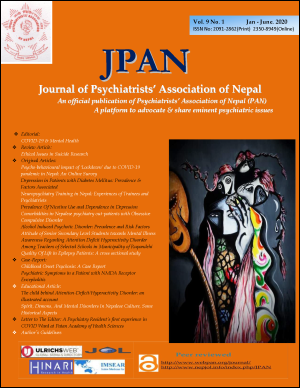Alcohol Induced Psychotic Disorder: Prevalence and Risk Factors
DOI:
https://doi.org/10.3126/jpan.v9i1.31335Keywords:
Alcohol Induced Psychosis, Prevalence, Risk FactorsAbstract
Introduction: Alcohol is a potent drug that can produce serious psychiatric symptoms including psychosis. It is believed that approximately 3% of alcoholic persons experience auditory hallucinations or paranoid delusions in the context of heavy drinking or withdrawal. Across Nepal, alcohol use varies widely and alcohol dependence is an increasing problem. So this study aims to provide information regarding prevalence and risk factors of Alcohol Induced Psychotic Disorder in context of Nepal.
Material And Method: A hosiptal-based cross- sectional study was carried out among 37 patients admitted in psychiatric inpatient ward at Nepal Medical College Teaching Hospital, Kathmandu with the diagnosis of AIPD from the period of Magh 2075 to Poush 2076. Semi-structured proforma developed by department of Psychiatry was used to collect socio- demographic data. The consent was taken from the patients and caregivers and strict inclusion and exclusion criteria were applied. Diagnosis was based on ICD-10 DCR criteria and the collected data was analyzed with SPSS.
Results: There were total 37 patients (29 males and 8 females) admitted with the diagnosis of AIPD and the prevalence of AIPD in our study was 6.19%. Among them majority of the patients (35.1%) were of age group (41-50) years and more than half were from rural areas (64.9%). Nearly half of the patients were educated upto primary level (45.9%) and (35.1%) were farmer by occupation. Also Hindus (56.8%) were found to be more associated with AIPD than Buddhist or Christian.
Conclusion: The findings of this study concluded that alcohol is a substantial problem in Nepal. The efforts should be used to increase public awareness about the problems associated with alcohol.
Downloads
Downloads
Published
How to Cite
Issue
Section
License
This license enables reusers to distribute, remix, adapt, and build upon the material in any medium or format, so long as attribution is given to the creator. The license allows for commercial use.




